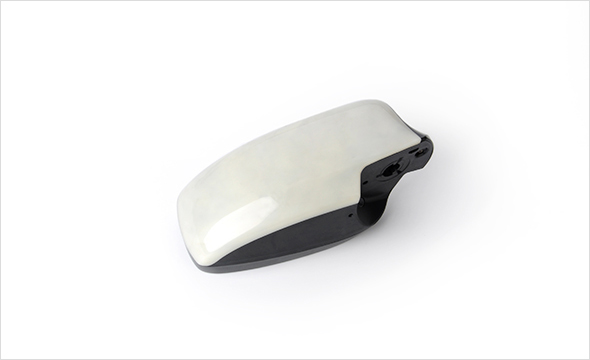
Automotive Lighting Molds
- Rear view mirror injection molded part This automotive lighting mould has below features: 1. Deep cavity mould 2. Big drop of the parting ling surface 3. Complicated part structure.
Rear view mirror
Producing a plastic injection-molded rearview mirror involves similar steps to those for creating game controller parts, with some specific considerations due to the mirror’s functional requirements and safety standards:
- Design: The design of the rearview mirror needs to account for the shape and curvature required for optimal visibility, as well as attachment points for mounting onto the vehicle. Additionally, considerations for anti-glare coatings or features may be included to enhance functionality.
- Material Selection: The choice of plastic material is critical for rearview mirrors to ensure sufficient strength, impact resistance, and optical clarity. Materials such as polycarbonate or acrylic are commonly used due to their durability and ability to maintain optical quality.
- Injection Mold Tooling: The mold for the rearview mirror needs to accurately reproduce the complex shape and curvature of the mirror housing. High-precision molds are essential to ensure the optical quality of the reflective surface and proper fitment of any additional components, such as mounting brackets or adjustment mechanisms.
- Injection Molding Process: The plastic material is heated to a molten state and injected into the mold cavity under high pressure. Care must be taken to control parameters such as temperature, pressure, and cooling rate to prevent defects like warping, sink marks, or optical distortions.
- Finishing Operations: After molding, the rearview mirror may undergo additional finishing operations such as trimming excess material, polishing or buffing the reflective surface, and applying any coatings or treatments required for anti-glare or UV protection.
- Assembly: Once the mirror housing is manufactured, it is assembled with other components such as the reflective glass or plastic insert, mounting hardware, and adjustment mechanisms. Quality control measures are essential during assembly to ensure proper alignment and functionality.
- Safety Compliance: Rearview mirrors for vehicles are subject to safety regulations and standards to ensure adequate performance and visibility. Manufacturers must ensure that their products meet these requirements through testing and certification processes.
Throughout each stage of production, rigorous quality control measures are essential to ensure that the rearview mirrors meet the required specifications for functionality, durability, and safety. This includes inspections during molding, dimensional checks, and functional testing of the assembled mirrors.
Previous « Game Controller
Next


